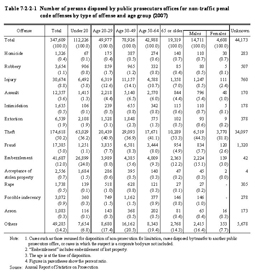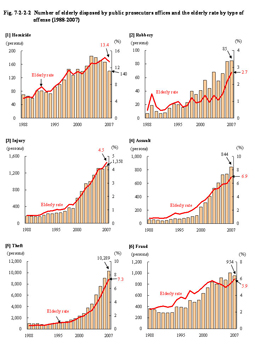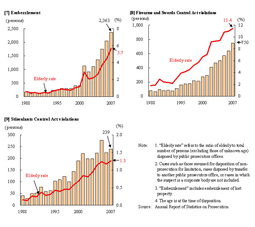| Previous Next Index Image Index Year Selection | |
|
|
1 Number of persons disposed Table 7-2-2-1 shows the number of persons disposed by public prosecutors offices for non-traffic penal code offenses by type of offense and age group in 2007. Table 7-2-2-1 Number of persons disposed by public prosecutors offices for non-traffic penal code offenses by type of offense and age group (2007) The number of elderly disposed by public prosecutors offices and the elderly rate were significantly less than the number of elderly cleared for non-traffic penal code offenses (48,605) and the elderly rate (13.3%) in 2007 (refer to Fig. 7-2-1-1).With theft cases the number of elderly cleared was 31,573 (refer to Table 7-2-1-4) but the number of elderly disposed by public prosecutors offices was less than 1/3 at 10,289. The number of elderly cleared was 10,672 and the number of elderly disposed by public prosecutors offices was less than 1/4 at 2,363 with embezzlement (including embezzlement of lost property) while the number of elderly cleared was 1,822 and the number of elderly disposed by public prosecutors offices was less than 1/2 at 844 with assault. Considering that shoplifting and other non-burglary theft accounted for over 90% of total theft cases and most of the embezzlement cases were for lost property, the reason for that reduction in the number of elderly disposed from the number of elderly cleared may be presumed to be that many of these cases were disposed by police as trivial offenses and not referred to public prosecutors offices. Fig. 7-2-2-2 shows the number of elderly disposed by public prosecutors offices and the elderly rate by type of offense over the last 20 years. Fig. 7-2-2-2 Number of elderly disposed by public prosecutors offices and the elderly rate by type of offense (1988–2007) The number of elderly disposed by public prosecutors offices and the elderly rate are both increasing for most major offenses.In addition, with Firearms and Swords Control Act violations and Stimulants Control Act violations, the number of elderly disposed by public prosecutors offices has an increasing trend with the elderly rate increasing every year. The elderly rate is especially high for Firearms and Swords Control Act violations, reaching 11.4% in 2007. |


